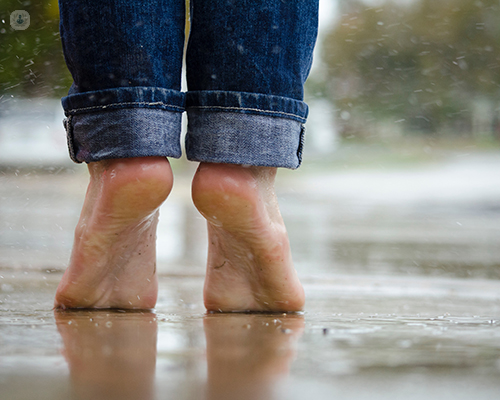Non-surgical treatment of arthritis of the foot and ankle
Escrito por:Arthritis is the degeneration of the joint cartilage causing pain and disability or dysfunction of the joint. There are a number of causes of arthritis, depending on which joint of the foot and ankle is affected. For example, the cause of arthritis in the big toe joint is often different to the causes of arthritis in the ankle. Primary osteoarthritis, which is often hereditary, is the most common cause of arthritis in the big toe. Post-traumatic arthritis, resulting from severe ankle fractures or recurrent ankle instability injuries is the most common cause of ankle arthritis, which can then cause degeneration of the joint. Other causes include inflammatory conditions such as gout, rheumatoid arthritis, septic arthritis, neuropathic arthropathy, or due to congenital deformities.

What are the symptoms of arthritis of the foot and ankle?
Symptoms of arthritis in the foot and ankle are usually the three cardinal symptoms that we see generally when describing arthritis. These are pain, swelling, and loss of function.
Essentially, the pain that one feels in an arthritic joint, particularly in the foot and ankle, is usually of an aching nature maybe described as a nagging, deep-seated pain, like a toothache. The pain is usually aggravated with activity or exercise, and is usually relieved with rest. As the arthritis progresses, one may even get pain at night.
Initially, the pain may be relieved with simple analgesics or anti-inflammatories, while the symptom of swelling is reduced with rest, ice packs, or anti-inflammatories.
The final symptom is loss of function, which is usually described by patients as a reduced range of movement. Patients will normally complain of stiffness in the affected joint, such as the ankle or the big toe, and this reduced activity is usually the result of pain arising from a degenerative joint.
How is arthritis of the foot and ankle treated?
Arthritis of the foot and ankle is a fairly complex presentation and therefore a thorough clinical assessment needs to be performed by the treating consultant. A full history is really important to discuss the contributing factors, for example if the patients had any specific trauma, or if they have any other inflammatory conditions which may be contributing to the arthritis.
Following this, a thorough examination is carried out by the consultant to assess the severity of the arthritis, its effect on neighbouring joints, and the level of functional disability that the patient may be experiencing. Once these factors have been considered, investigations such as x-rays, CT scans, or MRI scans may be carried out to complete the full picture.
Once we have all of this information together, the options of treatment are then discussed with the patient. Broadly speaking, there are two options for treatment: conservative measures or surgical treatment.
Non-surgical treatment of foot and ankle arthritis
There are a number of non-surgical options. These really depend on the particular joint affected in the foot and ankle.
Initially, simple medications such as pain killers, anti-inflammatory medications may reduce pain and swelling, particularly in foot arthritis.
For toe arthritis, specialised orthotics or insoles may help to alleviate any local pressure or pain arising caused by the shoe. With arthritis affecting the ankle, splints or braces may often help to offload weight bearing pressure and therefore help with pain symptoms.
The ankle is a very small joint compared to the hip and knee. However, it has the same amount of weight expressed upon it when standing and walking, and therefore weight loss is an important factor to consider, particularly with ankle arthritis. Using supports such as walking sticks or crutches can also help in alleviating the weight on the joint. Physiotherapy may also help improve the strength of the supporting muscles, especially around the ankle.
Guided injection techniques into specific joints may also be performed to help with the inflammation and pain associated with arthritis. These are usually performed under x-ray control, or under ultrasound control. If the patient’s symptoms deteriorate, then surgical options may be required. This includes simple fusion procedures or joint replacement procedures.
If you are concerned about arthritis in the foot and ankle, make an appointment with a specialist here.


